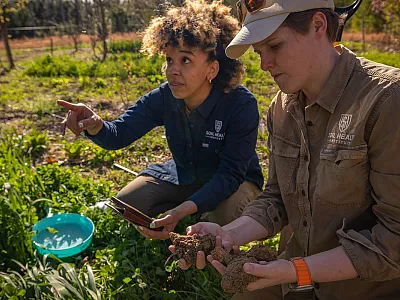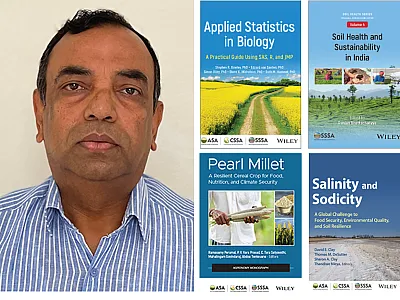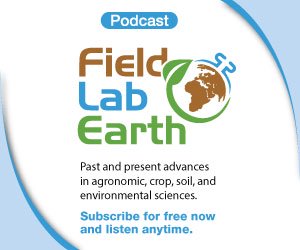The Race to Reduce Greenhouse Gas Emissions in U.S. Dairy Through Improved Soil Health
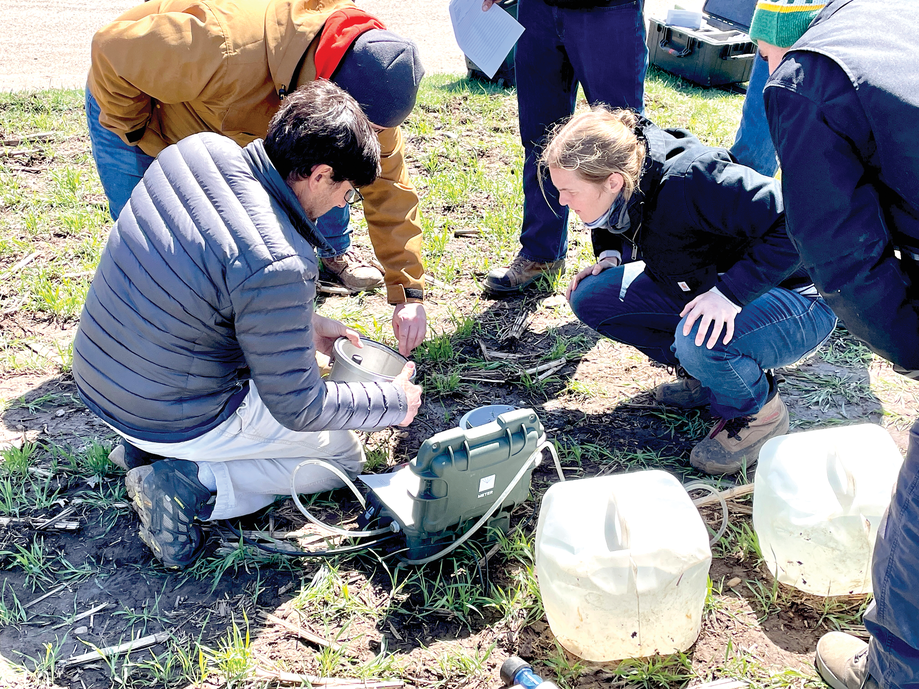

This is the first article in a new series in Crops & Soils magazine that will look at soil health and greenhouse gas emissions on U.S. dairies associated with crop production. Articles will cover soil health practices, data-based decision-making, greenhouse gas measurement in soils, manure application and storage, and informing future carbon markets with science. This article will discuss the Dairy Soil and Water Regeneration project. Using a whole-systems approach, project researchers are measuring how different management practices—from using cover crops to applying novel fertilizers, including manure-based products—affect soil health, potentially reduce greenhouse emissions and impact water quality under varying climate and field water management systems. Earn 0.5 CEUs in Sustainability by reading this article and taking the quiz.
With their eyes trained on climate solutions and sustainable businesses, more and more dairy farmers are implementing climate‐smart practices like cover cropping, conservation tillage, best management practices for manure application, and using novel manure‐based products with lesser environmental impacts. But there is something largely missing—data.
Quantifiable proof of the impacts of what dairy farmers do in the field is essential to informing their environmental and financial decisions and meeting the growing expectations of consumers, regulators, and business partners that food be produced sustainably. Unfortunately, very little has been done in the past to evaluate the impact of these soil health practices on greenhouse gas (GHG) mitigation in dairy feed production.
A first‐of‐its‐kind national project is beginning to change that. Through a six‐year effort called Dairy Soil and Water Regeneration (DSWR), the dairy community is zeroing in on research gaps in feed production practices and new manure‐based fertilizers. Filling those gaps is essential to farming today and will also inform new markets, incentives, and investments in dairy sustainability. The project, now in its second year, is the most expansive and in‐depth look at the environmental footprint of feed production practices on working dairy farms ever carried out in the U.S.
Rob Noble of Noblehurst Farms, a participating farm in western New York notes, “If we’re going to change our practices, we need to understand the value. There’s a big focus on data in agriculture right now. But if you can’t use it, what’s the point? This data is valuable because it will help us better utilize our resources. That’s why we’re participating.”
Aggressive Industrywide Goals
Dairy Soil and Water Regeneration is a key undertaking within the U.S. Dairy Net Zero Initiative (NZI), a groundbreaking and essential first phase in the dairy industry’s efforts to achieve its 2050 environmental stewardship goals, which were developed through the Innovation Center for U.S. Dairy. Those goals are to achieve GHG neutrality, optimize water use while maximizing recycling, and improve water and soil by optimizing the utilization of manure and nutrients. The U.S. Dairy Net Zero Initiative is producing foundational research, conducting on‐farm pilots, and establishing local/regional networks that will be key to unlocking dairy’s potential to address GHG emissions, water efficiency, and water quality on farms and in the field.
Since launching in 2020, NZI has initiated and supported 26 projects spanning 338 farms across 19 states, leveraged $37.7 million in support from partners, and established more than 65 partnerships with corporate partners, the dairy community, land grant and research institutions, governmental and non‐governmental organizations, and other stakeholders.
The vigorous approach matches the urgency in the market. Global and U.S. food companies are seeking to meet aggressive environmental goals, and surveys show sustainability has grown in importance for U.S. consumers. Recent surveys have shown that:
- 57% are aware of regenerative agriculture (up 10 percentage points from 2019; see https://t.ly/Yf1r).
- 62% have switched to comparable products or services that have a positive impact on the environment (2021 report at https://www.kantarworldpanel.com/cn‐en/publications/Reports).
- 55% stopped buying certain products or services because of their negative impact on the environment (2021 report at https://www.kantarworldpanel.com/cn‐en/publications/Reports).
- 36% view foods grown using regenerative ag practices as more nutritious (2021 report at https://foodinsight.org/2021‐food‐health‐survey/).
Dairy’s Soil Solutions
In 2008, the Innovation Center and other dairy industry partners were the first in the food agricultural sector to conduct a full life cycle assessment at a national scale. The assessment, which focused on fluid milk, estimated that U.S. dairy accounts for approximately 2% of total GHG emissions, 5.1% of water use, and 3.7% of U.S. farmland. Due to increasingly modern and innovative dairy‐farming practices, the environmental impact of producing a gallon of milk in 2017 shrunk significantly, requiring 30% less water, 21% less land, and a 19% smaller carbon footprint than it did in 2007. That’s the same as the amount of carbon dioxide removed from the atmosphere by half a million acres of U.S. forest.
With roughly 80% of the U.S. dairy value chain’s carbon footprint traced back to the farm, dairy farmers can have a direct impact and are well positioned to be leaders in adopting climate‐smart practices. This includes in‐field practices and manure management, which make up more than half of a dairy farm’s GHG footprint. Feed production itself comprises about 26% of GHG emissions on dairy farms.
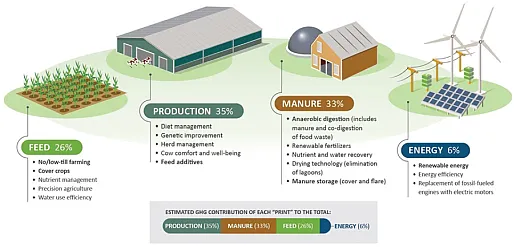
But, to reach both environmental and financial goals, farmers need science‐driven guidance. This is where DSWR comes in.
Using a whole‐systems approach, project researchers are measuring how different management practices—from using cover crops to applying novel fertilizers, including manure‐based products—affect soil health, potentially reduce GHG emissions, and impact water quality under varying climate and field water management systems.
The work began in 2021 with a baseline survey of soil health and carbon storage on dozens of dairies representing climates and soils across the country. So far, researchers have collected hundreds of soil samples. The samples are not your typical quick soil sample, but rather time consuming as the project is seeking much more information per sample.
Following the collection of baseline data, researchers will dive more deeply to track a smaller number of farms across growing seasons and compare traditional soil health practices to advanced practices like strip‐till, no‐till, manure application methods, new manure products, cover crops, and planting green. Eleven farms, including six commercial dairies, three university research dairies, one USDA research farm, and an almond farm, are participating in the extended research through large‐plot and field‐scale trials.
The third stage of the project will be to share results and research avenues for revenue‐generating projects and markets.
A Data Opportunity
Soil‐sampling data collected will provide a scientific baseline for measuring carbon sequestration and soil health. Data also provide a reference measurement of current soil health and carbon storage on U.S. dairies and help the team understand geographical transferability of existing modeling platforms that simulate soil carbon storage with changes in management.
The large‐plot studies will gather much more in‐depth data on six participating farms across the U.S. The studies will include replicated experiments evaluating tillage, cover cropping, and manure‐based products and their effects on soil health, soil carbon stocks, water quality and quantity, greenhouse gas emissions, and other agronomic factors.
The field‐scale studies, conducted in partnership with five farms, will help the team demonstrate the advantages of soil health management systems at scale. All data also will be used to improve model performance to more accurately estimate what will happen if a dairy farm starts implementing new forage management techniques.
Of specific interest to crop advisers and farmers will be a more comprehensive soil analysis that goes beyond the industry standard of basic soil testing looking mostly at soil chemistry. While these tests are reliable and familiar for practitioners to use, there is tremendous interest in more comprehensive soil evaluation that incorporates physical (bulk density) and biological (POXc, which measures active carbon, as an example). This will be expanded upon in a later article.
Collaborative Commitment
In addition to the numerous farms, a host of research partners and others are participating. The Innovation Center is managing the project, and the Soil Health Institute is overseeing the research.
Six universities are conducting research: Cornell University in New York, Texas A&M AgriLife Research, University of California–Davis, University of Wisconsin–Madison, University of Wisconsin–Platteville, and the University of Vermont. The USDA‐ARS Northwest Irrigation and Soils Research site in Kimberly, ID, is also conducting research.
Funding comes from a diverse group. The project is largely supported by the Foundation for Food & Agriculture Research, which awarded $10 million for the work. Global entities Starbucks and Nestlé are each contributing funding through NZI. Dairy Management Inc. and Newtrient are also supporters.
Expectations for the project are high. By 2026, the dairy community and its partners are hopeful they’ll have data that accurately reflect farms’ GHG footprint for dairy crop rotations with consideration for soil health management practices, water quality, and new manure‐based products. The results will be shared broadly to provide scientific accuracy to support the measurement and modeling of dairy’s GHG footprint for feed production and to inform carbon markets. The findings will have lasting impacts on how dairy farmers grow feed and shape their carbon footprints in a climate‐smart future.
Self-Study CEU Quiz
Earn 0.5 CEUs in Sustainability by taking the quiz. For your convenience, the quiz is printed below. The CEU can be purchased individually, or you can access as part of your Online Classroom Subscription.
- Which of the following statements is NOT true according to recent surveys of U.S. consumers? More than half
- have switched to comparable products or services that have a positive impact on the environment
- view foods grown using regenerative ag practices as more nutritious.
- have stopped buying certain products or services because of their negative impact on the environment.
- are aware of regenerative agriculture.
- In 2008, the life cycle assessment of the Innovation Center and other dairy industry partners estimated that U.S. dairy accounts for approximately ____ of total GHG emissions
- 2%
- 3.7%
- 5.1%
- 7%
- Feed production comprises ____ of GHG emissions on dairy farms.
- 10%
- about a quarter
- more than half
- roughly 80%
- The project mentioned in this article will seek to scale-up soil sampling and streamline the process using basic testing that looks mostly at soil chemistry instead of more comprehensive and time-consuming evaluations that incorporate physical and biological components.
- True
- False
- By ____, the dairy community and its partners are hopeful they’ll have data that accurately reflect farms’ GHG footprint for dairy crop rotations with consideration for soil health management practices, water quality, and new manure-based products.
- 2024
- 2025
- 2026
- 2027
Text © . The authors. CC BY-NC-ND 4.0. Except where otherwise noted, images are subject to copyright. Any reuse without express permission from the copyright owner is prohibited.




